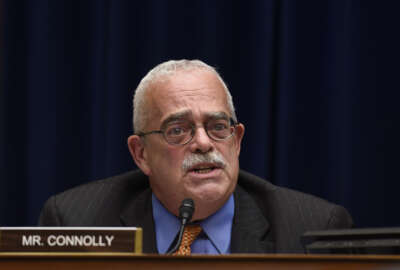

As lawmakers return to Capitol Hill to continue appropriations discussions this coming week, the Trump administration's proposed OPM-GSA merger will be the elephant...
With Congress out this past week for the Memorial Day recess, much of the discussion about the Trump administration’s proposed merger of the Office of Personnel Management with the General Services Administration has been put on hold.
At a May 21 hearing on the proposal before the House Oversight and Reform Government Operations Subcommittee, the panel’s chairman, Gerry Connolly (D-Va.) said the discussion with members that day was “the first big step in the dialogue” with Congress.
Lawmakers return to Capitol Hill next week and will resume budget talks and discussions on 2020 appropriations bills. And as the House Appropriations Financial Services and General Government Subcommittee is scheduled to mark up its 2020 proposal Monday evening, questions about the future of OPM and its potential for reorganization will likely resurface.
Here are five questions about the OPM-GSA merger to watch for in the coming months.
A legislative proposal, which the Office of Management and Budget sent to Capitol Hill May 16, would transfer most of the roles, responsibilities and authorities of the OPM director to the GSA administrator. It would also create and build out the personnel policy within OMB under a newly renamed Office of Federal Workforce Policy. This office would be staffed with a presidentially-appointed leader and a handful of other employees.
But no member yet has stepped forward to sponsor the legislation.
Rep. Mark Meadows (R-N.C.), ranking member of the government operations subcommittee, could be a natural contender to sponsor the administration’s proposed legislation given his leadership role on the Oversight and Reform Committee and in the House.
But Meadows didn’t appear ready to jump on board with the proposed OPM-GSA merger just yet. He, like many of the committee members, asked Margaret Weichert, OPM’s acting director and deputy director for management at OMB, for more details and information to support the proposed merger.
He also asked the Government Accountability Office — which also criticized the administration’s OPM-GSA merger proposal as lacking in detail — to weigh in on what agencies performed certain shared services and other functions on behalf of others particularly well.
Disappointment and skepticism from GAO and the OPM inspector general didn’t score any points with Republicans either.
Besides Meadows, both Democrats and Republicans on the subcommittee seemed equally skeptical of the administration’s proposal for the OPM-GSA merger. Both D.C. Del. Eleanor Holmes Norton and Rep. Glenn Grothman (R-Wis.) said the administration didn’t have much time to drum up congressional support and enact a reorganization bill into law.
“Do you think it’s reasonable to expect Congress to enact legislation this significant in less than a year-and-a-half?” Grothman said. “That seems almost kind of funny, doesn’t it?”
The May 21 hearing made one thing clear: There doesn’t seem to be immediate, bipartisan support for the OPM-GSA merger without more details and information from the Trump administration.
Developing a more detailed plan for the merger will take time, and neither the administration nor Congress has much of it.
Based on the direction of an April executive order, OPM’s security clearance business is set to transfer to the Pentagon on Oct. 1. With the move, OPM faces a $70 million shortfall through the lost background investigation business.
In the Trump administration’s mind, Congress has no choice but to merge OPM with GSA.
Lawmakers could, however, appropriate more money to the agency, but it’s unclear how much more OPM would need to stay financially sound without the security clearance business.
And when it comes to OPM, lawmakers have never been big spenders in the recent past. The agency received $272 million in 2016, $289 million in 2017 and $287 million in 2018, according to past congressional budget justifications.
In addition, Congress’ tendency to procrastinate and enact continuing resolutions for several months of the next fiscal year could complicate OPM’s financial situation if lawmakers don’t pass additional appropriations for the agency by the start of the new fiscal year — or if they don’t approve the $50 million the administration requested to cover the proposed merger in fiscal 2020.
No alternative to the administration’s proposed OPM-GSA merger was discussed at the May 21 hearing, and it’s unclear what other options are on the table.
Well before the May 21 hearing, Democrats on the House Oversight and Reform Committee urged appropriators on the financial services and general government subcommittee to prohibit the use of funds for the OPM-GSA merger unless lawmakers receive a detailed analysis of the administration’s plans.
But based on members’ reactions to the details the administration had provided as of May 21, House Democrats aren’t likely to renege on their original request to appropriators.
Look to the upcoming House financial services appropriations markup, which has jurisdiction over OPM, GSA and OMB, for a greater sense of whether Congress will bite on the administration’s merger proposal, explore another funding option, or do nothing at all.
In a roundtable with reporters earlier this month, Weichert said the administration could take other steps to effectuate pieces of the OPM-GSA merger.
OPM’s National Background Investigations Bureau (NBIB) and security clearance business is already halfway out the door. The transfer will become official on Oct. 1.
In the meantime, Weichert said OPM could outsource some of its functions and assets for GSA to manage. OPM also already agreed to use GSA’s Centers of Excellence initiative to help the agency modernize its legacy systems.
Other joint venture actions and partnerships may be on the horizon, Weichert has said.
What’s left of OPM, namely its health insurance and retirement functions, as well as the agency’s offices that handle personnel policy activities, would be a skeleton of what they are today — unless Congress were to appropriate more funding to OPM.
“I am hopeful, if not optimistic, that Congress will engage with us on finding solutions here,” Weichert told reporters. “Because at the end of the day, we can’t fail to deliver here. The choices we’d be left with, if we don’t have the synergies with GSA on things like overhead … [and] shared services, what’s going to get squeezed are the missions that people care a lot about.”
Rep. Jamie Raskin (D-Md.) questioned why the administration was comfortable with DoD’s plan to use legacy IT systems at the National Background Investigations Bureau (NBIB) — especially if OPM’s technology was as bad as Weichert said it was.
“In very short term, we are the solution that the government has,” Weichert said.
The Defense Department has been developing a new security clearance case management system, called the National Background Investigation Service (NBIS), for the past two years.
NBIS, however, isn’t ready yet. Defense officials last week awarded a $75 million other transaction agreement to build a portion of NBIS.
As development continues on NBIS, the Pentagon is planning to use OPM’s legacy case management system. DoD will reimburse OPM for the costs of operating and maintaining that system, officials have said, though the dollar amount isn’t known yet.
“I do have concerns, and I particularly have concerns actually about separating the background investigation code-base, which sits on the same Z-12 legacy mainframe system as the retirement [services] capability,” Weichert said of the plan. “I do have concerns about that. What we’re thinking about to mitigate the risk of that is rather than rip it out, over time we will shift the new cases to the new system at DoD. Over time, [we] will essentially wind down what’s at OPM. That represents the least new risk to the overall system.”
Copyright © 2025 Federal News Network. All rights reserved. This website is not intended for users located within the European Economic Area.
Nicole Ogrysko is a reporter for Federal News Network focusing on the federal workforce and federal pay and benefits.
Follow @nogryskoWFED


